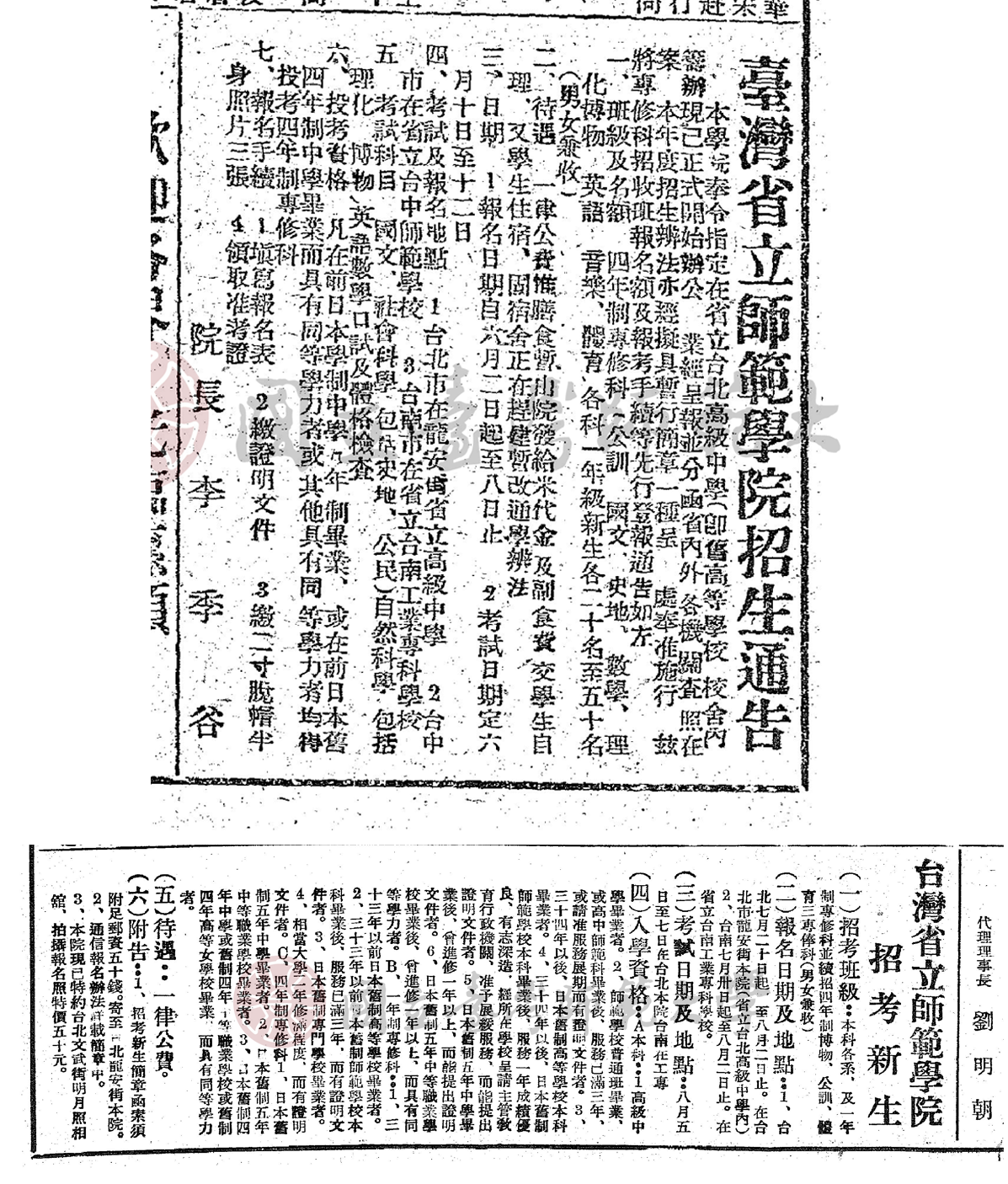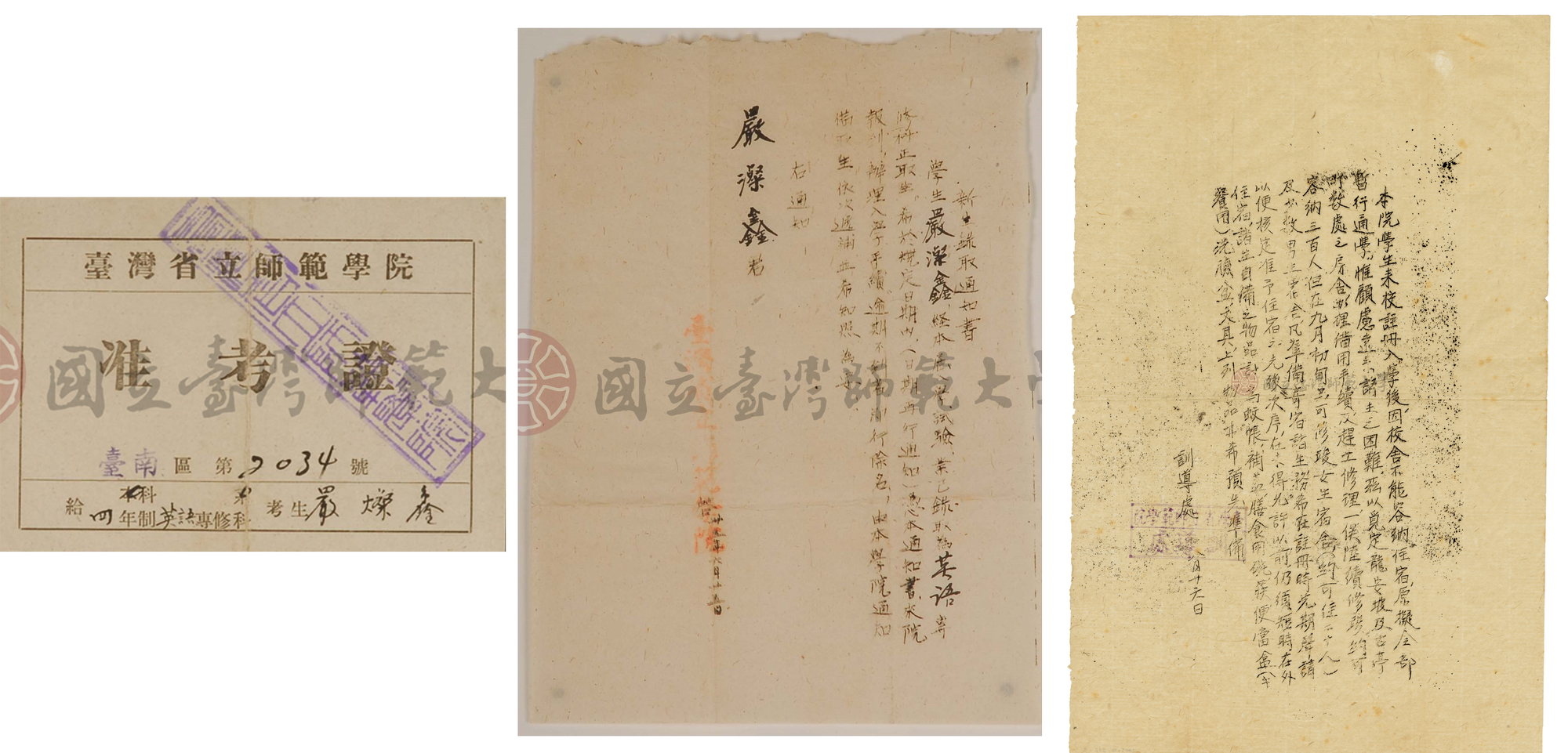
Shortly after the end of World War II, the Governing Council under the Province of Taiwan took over and began reforming education based on the new government’s Sinicization Policy. There was a severe shortage of teachers across various subject areas in secondary school, leading to an urgent need for new teachers. In order to train teachers with Chinese cultural literacy, the Governing Council originally planned to temporarily establish the Taiwan Provincial College of Liberal Arts, but encountered public backlash. In April 1946, the Council announced that it would instead establish a teachers’ college. The College Preparatory Committee temporarily took up office at Taipei High School on Long’an Street (formerly the site of Taihoku Higher School). On June 5 of the same year, Taiwan Provincial Teachers College was officially established, using part of Taipei High School’s buildings for classes.
Taiwan Provincial Teachers College was first established with seven departments—Education, Chinese, English, History and Geography, Mathematics, Physics and Chemistry, and Natural History. In addition, to train the secondary school teachers urgently needed in Taiwan, it offered nine specialized training courses in Civic Education, Chinese, English, History and Heography, Mathematics, Physics and Chemistry, Natural History, Physical Education, and Music, as well as a general one-year specialized training course not divided by subject area.
In 1947, a four-year specialized training course in Arts and Handicrafts was added. The following year, three new departments—Physical Education, Music, and Fine Arts—were established, and the Civic Education specialized training course was renamed the Education specialized training course. With the exception of the Chinese specialized training course, which continued until the spring of 1952, all other specialized and preparatory training courses were either reorganized into departments or discontinued after the graduation of the first cohort of students. In February 1953, the school was ordered to add a Department of Industrial Education. In August of the same year, the Department of Home Economics Education was established. With this addition, the school’s departmental structure became more complete, comprising a total of 12 departments: Education, Chinese, English, History and Geography, Mathematics, Physics and Chemistry, Natural History, Physical Education, Music, Fine Arts, Industrial Education, and Home Economics Education.
Despite limited resources and makeshift school buildings, the birth of Taiwan Provincial Teachers College signified that Taiwan finally had an independent institution of higher learning that could train secondary school teachers. The school shouldered the important responsibility of producing a new generation of intellectuals in Taiwan and laid an important foundation for the future development of education in Taiwan.

In the early days of its establishment, Taiwan Provincial Teachers College adopted independent admissions, with examination centers in Tainan, Taichung, and Taipei. In 1947, it switched to a joint admissions system with Tainan Technical College (now National Cheng Kung University) and Taichung College of Agriculture (now National Chung Hsing University), organized by Taiwan Provincial Teachers College. In 1954, National Taiwan University joined the joint admissions system, marking the beginning of Taiwan’s joint entrance examination system.
As to the admissions process, in June 1946, entrance exams were first held for the nine four-year specialized training courses: Civic Education, Chinese, English, History and Geography, Mathematics, Physics and Chemistry, Natural History, Physical Education, and Music. In September of the same year, students were admitted into undergraduate programs in seven departments: Education, Chinese, English, History and Geography, Mathematics, Physics and Chemistry, and Natural History.
Five-year undergraduate programs required five years of study, with the final year being an internship in a secondary school. Students who then passed the required examinations were awarded a bachelor’s degree. Four-year specialized training courses required four years of study, with the final year being an internship as a teacher at a junior high school. One-year specialized training courses admitted students who had completed at least two years of university study, and provided one year of professional training regardless of their original field of study. Students who completed their studies and passed the required examination were issued a graduation certificate. In the years that followed, the college’s departmental structure gradually developed to become more comprehensive, and school operations gradually got on track.

In 1946, the Department of Education, under the Taiwan Provincial Government, formulated the Regulations on Publicly Funded Benefits for Normal School Students in Taiwan Province《臺灣省師範生公費待遇辦法》 based on the Regulations for the Implementation of Publicly Funded Benefits for Normal School Students Nationwide promulgated by the Executive Yuan, stipulating that publicly funded benefits include exemption from tuition and miscellaneous fees, provision of rice and supplementary meal subsidies, uniform expenses, book expenses, academic expenses, internship material expenses, graduation trip expenses, and travel expenses for graduates assigned to service posts.
In addition, Article 5 of the Academic Regulations of Taiwan Provincial Teachers College stipulated: “Anyone who obtains formal student status will receive publicly funded benefits and will be exempt from all tuition, food, accommodation, and miscellaneous fees.” In addition to being exempt from tuition, miscellaneous, and accommodation fees, students of Taiwan Provincial Teachers College also received a monthly living allowance based on the standards of each period, including several kilograms of brown rice as a staple food and a cash subsidy for supplementary meals. In most cases, the school converted the brown rice into its cash equivalent and distributed it together with the supplementary meal subsidy. With publicly-funded support, students’ basic living expenses were taken care of, which enabled them to focus all of their time and attention on their studies and teacher training courses. Until 1994, NTNU students enjoyed the privileges of a “tuition-free education and stipend allocation” through the publicly funded benefits system.
Before starting formal classes at Taiwan Provincial Teachers College, freshmen students were required to undergo two weeks of freshman orientation, which was conducted under military-style management, with an emphasis on moral education. The freshman orientation was meant to help students get accustomed to college life and get to know their teachers as quickly as possible. Today, the freshman orientation has been transformed into a Freshman Camp, newly named Bo Le Academy, which welcomes new students to NTNU. The military-style management of yore has become a thing of the past.